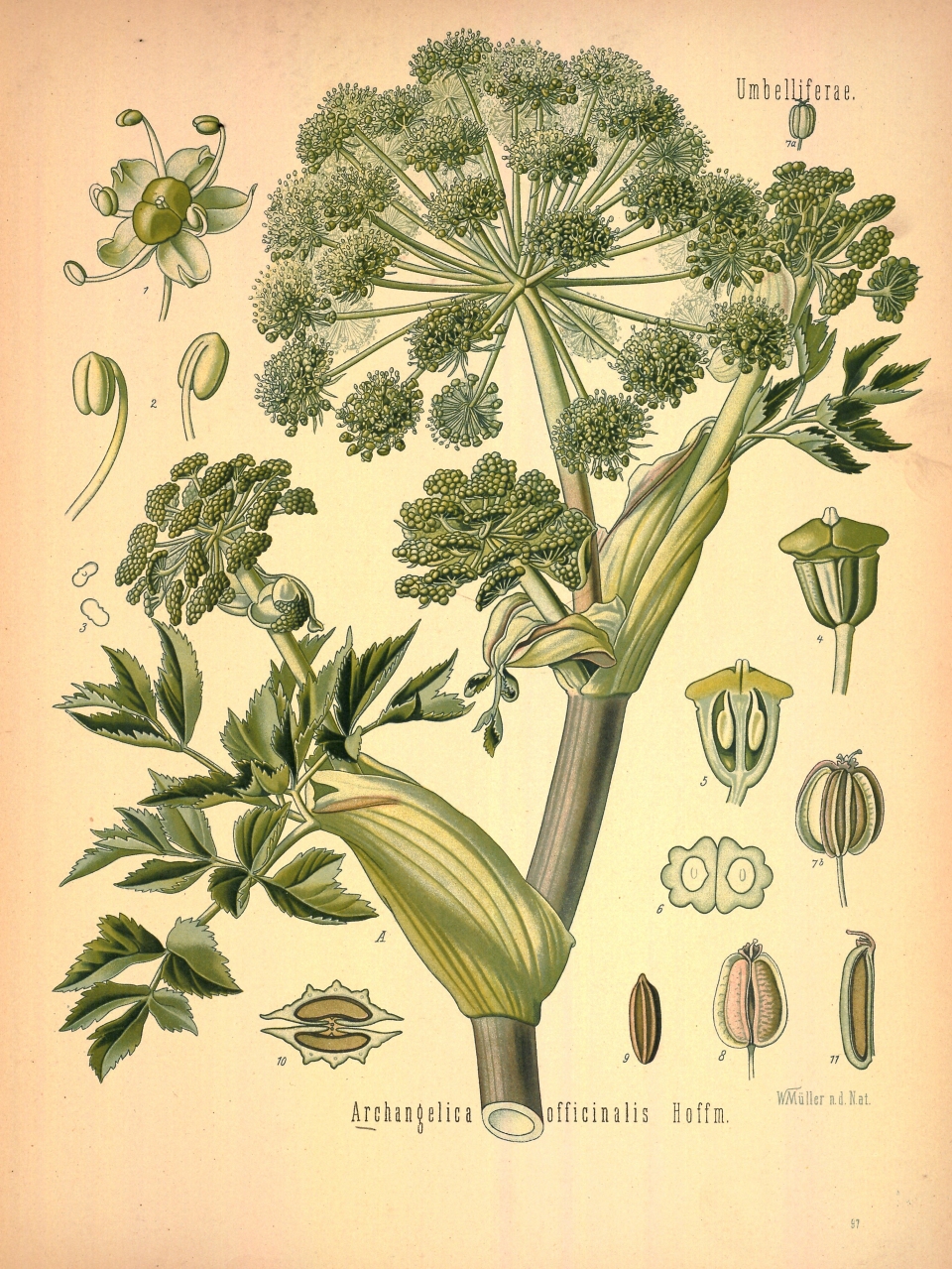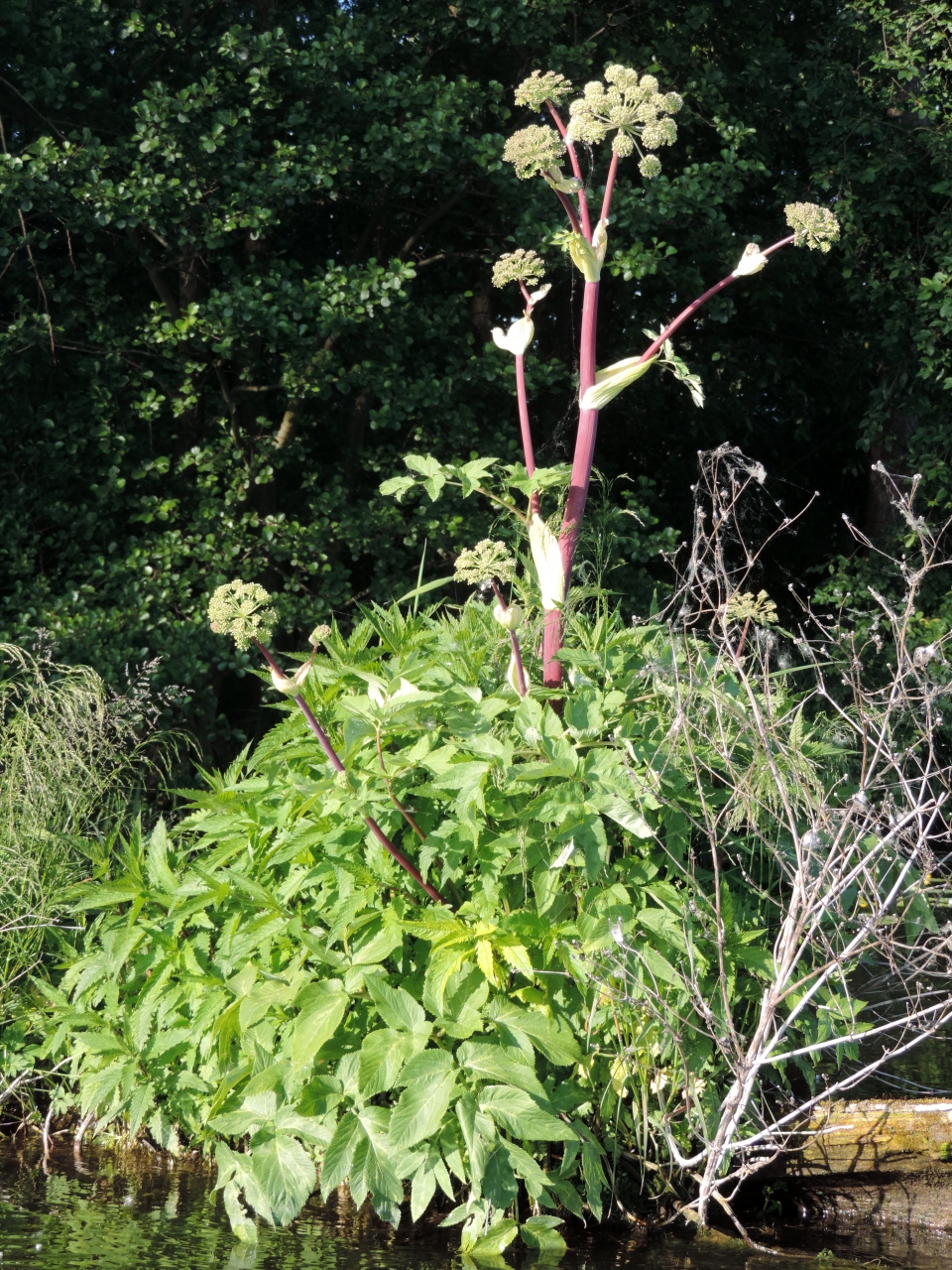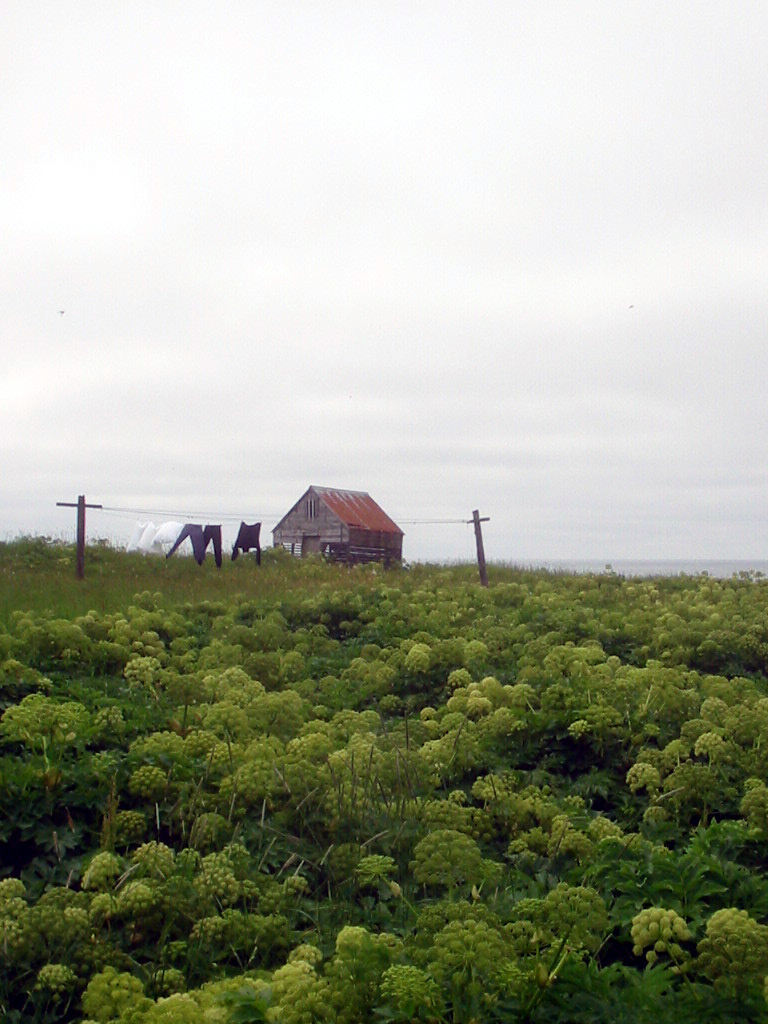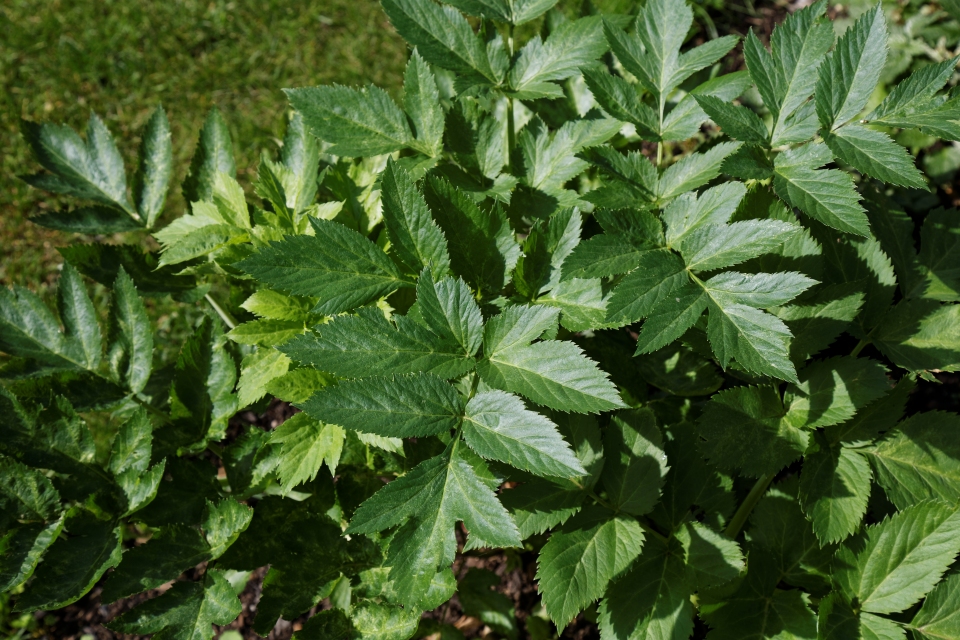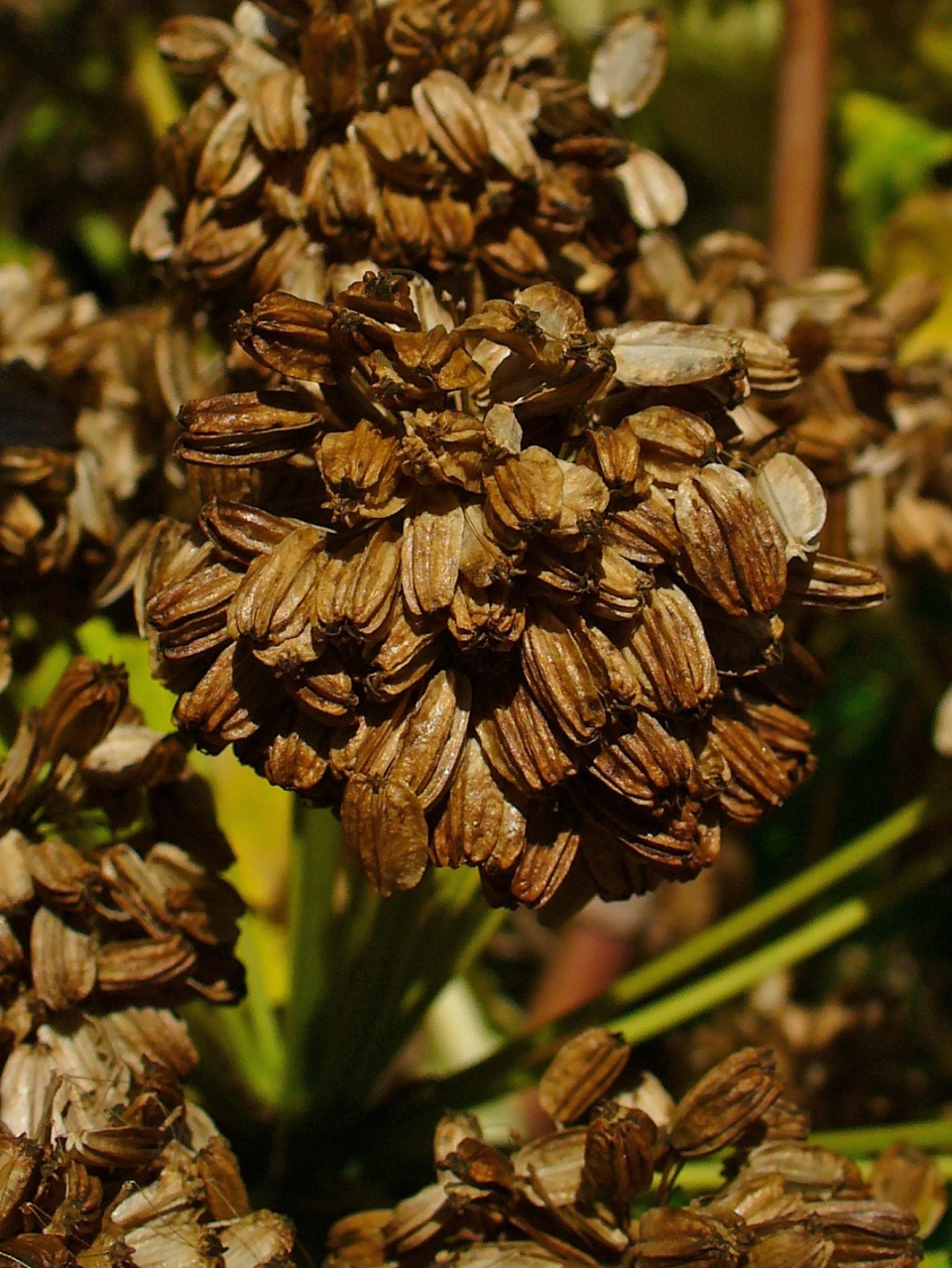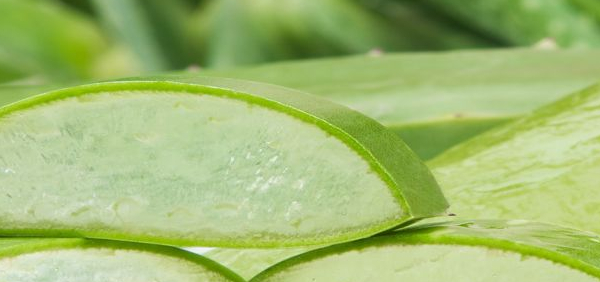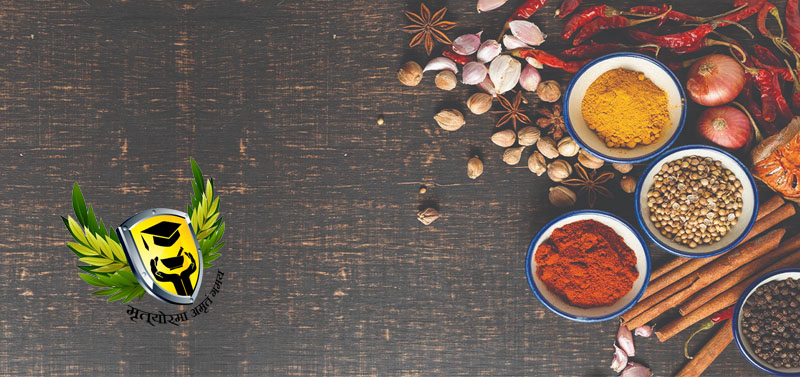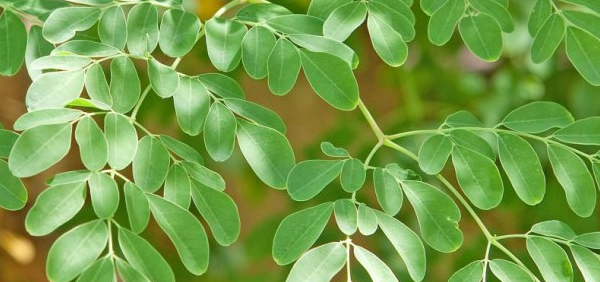canda :
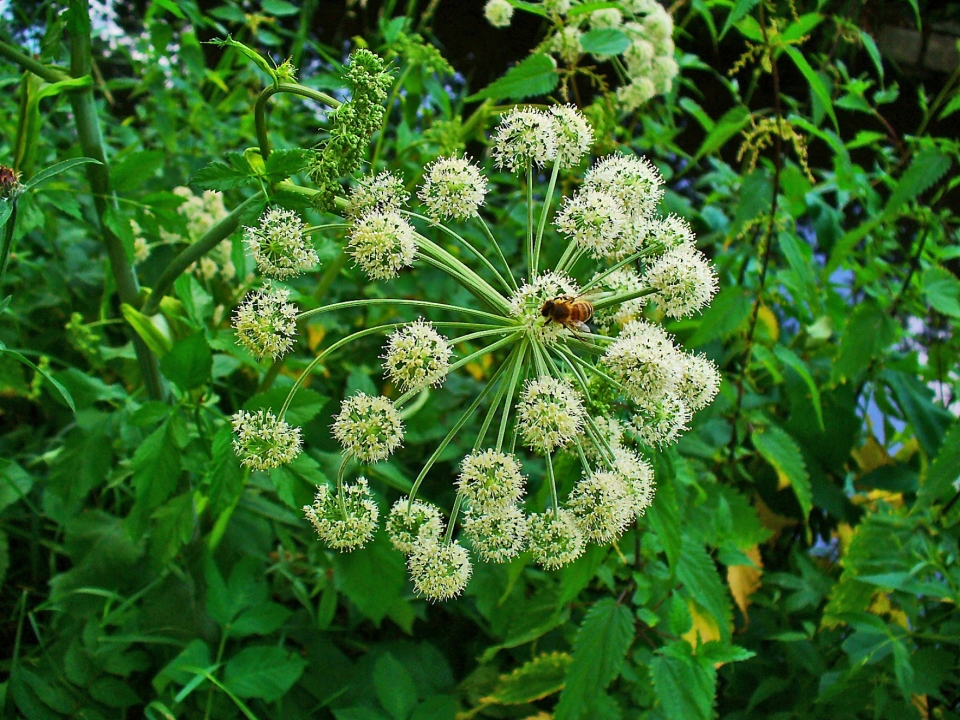 Angelica archangelica, commonly known as garden angelica, wild celery, and Norwegian angelica, is a biennial plant from the family Apiaceae, a subspecies of which is cultivated for its sweetly scented edible stems and roots. Like several other species in Apiaceae, its appearance is similar to several poisonous species (Conium, Heracleum, and others), and should not be consumed unless it has been identified with absolute certainty. Synonyms include Archangelica officinalis Hoffm. and Angelica officinalis Moench.
Angelica archangelica, commonly known as garden angelica, wild celery, and Norwegian angelica, is a biennial plant from the family Apiaceae, a subspecies of which is cultivated for its sweetly scented edible stems and roots. Like several other species in Apiaceae, its appearance is similar to several poisonous species (Conium, Heracleum, and others), and should not be consumed unless it has been identified with absolute certainty. Synonyms include Archangelica officinalis Hoffm. and Angelica officinalis Moench.HISTORICAL AND MYTHOLOGICAL REVIEW:
From the 10th century on, angelica was cultivated as a vegetable and medicinal plant, and achieved popularity in Scandinavia in the 12th century and is used especially in Sami culture. Angelica is a shamanic medicine among the Saami or Laplanders.Taxonomical Classification
Kingdom: Plantae - Plants
Subkingdom: Streptophyta
Superdivision: Spermatophyta - Seed plants
Division: Magnoliophyta - Flowering plants
Class: Magnoliopsida - Dicotyledons
Family: Umbelliferae
Genus: Angelica
Species: Angelica archangelica
VERNACULAR NAMES
Sanskrit: Laghu CorakaEnglish: Holy Ghost, Wild Celery, and Norwegian angelica.
Hindi: Choraka bheda, Dudhachoraa
Urdu: انجلیق
Telugu: అంజెలికా
Tamil: ஆஞ்சலிகா
Malayalam: Njara-ഞറ
Kannada: ಏಂಜೆಲಿಕಾ
Arabic: Hashisha al malik
Spanish: Angelica
Japanese: シシウド, アンゼリカ
Chinese: 当归
French: Angélique, achangélique, herbe du Saint−Espr
German: arznei-engelwurz
Persian: gol-par
Greek: αγγελική
Varities:
In Western herbal medicine, the two most common varieties of Angelica that are used are European Angelica (Angelica archangelica, Angelica officinalis) and American Angelica (Angelica atropurpurea, Angelica spp.).Definition
Archangelica comes from the Greek word "arkhangelos" (=arch-angel), due to the belief that it was the archangel Michael who told of its use as a medicineSynonyms
Synonyms in Ayurveda: canda, phalachoura, taskara, kitava, krodhana, pishuna, gouri, shankhinika, shathi, douhkuleya-dushkulaArchangelica comes from the Greek word arkhangelos (=arch-angel), due to the myth that it was the angel Gabriel who told of its use as a medicine. In Finnish it is called vainonputki, in Kalaallisut kuanneq, in Sami fadnu, boska, and rassi, in English garden angelica, in German arznei-engelwurz, in Dutch grote-engelwortel, in Persian gol-par, in Swedish kvanne, in Norwegian kvann, in Danish kvan, in Icelandic hvonn, and in Faroese it has the name hvonn
Rasa: Katu
Guna: Laghu Teeskhsna
Veerya: Ushna
Vipaka: Katu
Karma: Kaphahara Vatahara
Kaphahara, Mutrala, Vatahara, Visaghna, Svasahara, Varnaprasadaka, Svedaghna, Kandughna, Daurgandhahara
Cultivation:
Cultivate in ordinary deep, moist loam, in a shady position, as the plant thrives best in a damp soil, and loves to grow near running water. Although the natural habitat is in damp soil and in open quarters, yet it can withstand adverse environment wonderfully well, and even endure severe winter frost, without any injury. Seedlings will even successfully develop and flower under trees, whose shelter creates an area of summer dryness in the surface soil, but of course, although such conditions may be allowable when Angelica is grown merely as an ornamental plant, it must be given the best treatment as regards suitable soil and situation, when grown for its use commercially. Insects and garden pests do not attack the plant with much avidity: its worst enemy is a small two-winged fly, of which the maggots are leaf miners, resembling those of the celery plant and the spinach leaf.Propogation:
Propagation should not be attempted otherwise than by the sowing of ripe, fresh seeds, although division of old roots is sometimes recommended, and also propagation by offshoots, which are thrown out by a two-year old plant, when cut down in June for the sake of the stems, and which transplanted at two feet or more apart, will provide a quick method of propagation, considered inferior, however, to that of raising by seed. As the germinating capacity of the seeds rapidly deteriorates, they should be sown as soon as ripe in August or early September. If kept till March, especially if stored in paper packets, their vitality is likely to be seriously impaired. In the autumn, the seeds may be sown where the plants are to remain, or preferably in a nursery bed, which as a rule will not need protection during the winter. A very slight covering of earth is best. Young seedlings, but not old plants, are amenable to transplantation. The seedlings must be transplanted when still small, for their first summers growth, at a distance of about 18 inches apart. In the autumn they can be removed to permanent quarters, the plants being then set three feet apart.Harvesting:
Phytochemistry:
PHARMACOLOGY:
IMPORTANT FORMULATIONS – Manjisthadi TailaParts used for medicinal purpose
Root, ,Dosage:
1-3 g.Antidote:
According to the legend, the plant was revealed to a monk by an angel as an antidote to the bubonic plague.Substitute:
Wild angelica (Angelica sylvestris) has often been regarded as the poor mans substitute for garden angelica (Angelica archangelica).Adultrants:
Angelica silvestris radixControversy:
Commercial value:
Angelica has a long folk-history of use as a medicinal herb, in particular for the treatment of digestive disorders and problems with blood circulationMorphology:
Tap root thick, twisted, fleshy, highly aromatic with numerous rootlets, grayish in color; odor, musk-like; taste, sweet.Histology:
Geographical distribution:
Angelica archangelica grows wild in Russia, Finland, Sweden, Norway, Denmark, Greenland, the Faroe Islands, and Iceland, mostly in the northern parts of the countries. It is cultivated in France,ECOLOGICAL ASPECT:
According to some botanists, this species of Angelica is believed to be a native of Syria from where it has spread to many cool European climates, where it has become naturalized. It is occasionally found native in the cold and moist places in Scotland, but is more abundant in countries further north, such as, Lapland and Iceland. It is supposed to have come to this country from northern latitudes in about 1568; there are about thirty varieties of Angelica, but this one is the only one officially employed in medicine. Parkinson, in his Paradise in Sole, 1629, puts Angelica in the forefront of all medicinal plants, and it holds almost as high a place among village herbalists to-day, although it is not the native species of Angelica that is of such value medicinally and commercially, but an allied form, found wild in most places in the northern parts of Europe. This large variety, Angelica Archangelica (Linn.), also known as Archangelica officinalis, is grown abundantly near London in moist fields, for the use of its candied stems. It is largely cultivated for medicinal purposes in Thuringia, and the roots are also imported from Spain.Plant conservation:
Least Concern (IUCN)General Use:
The herb, including the fruits and roots, is used for flavoring, and is reported to possess carminative properties. The root is aromatic and is reported to possess diaphoretic and diuretic properties, and is used in flatulent colic. It is sometimes applied externally as a counter-irritant. Internally it is used in digestive complaints, flatulence or as a tonic for cold and the respiratory systemTherapeutic Uses:
Kaphahara, Mutrala, Vatahara, Visaghna, Svasahara, Varnaprasadaka, Svedaghna, Kandughna, DaurgandhaharaSystemic Use:
It is widely used in the treatment of a variety of diseases like plague, pleurisy, cough, flu, bronchial catarrh, rheumatism, uterine stimulant, etc. In fact, it is the most widely used European plant. It is especially useful in menstrual disorders. It regulates periods, and helps in expulsion of placenta after delivery.Pharmacological:
* AntiCancer * Antitussive * Aromatic * Bitter * Carminative * Cordial * Diaphoretic/sudorific * Emmenagogue * Expectorant * Nervine * Stimulant * Stomachic * TonicClinical trials:
Research:
Precautions:
Toxicity studies:
Use in other system of medicine:
CONCLUSION:
Photos of canda -
- Courtesy: http://temperate.theferns.info/plantimages/4/6/4621eeb32f638f116ceb9fcd4dbf116f4ef42ad1.jpg
- Courtesy: http://temperate.theferns.info/plantimages/e/d/ed88992728114e64dd1fa9fa4f9bf01bba3f468c.jpg
- Courtesy: http://temperate.theferns.info/plantimages/e/f/ef48d2f1ae44d84f9ecd4ecf92e6361f735057d8.jpg
- Courtesy: http://temperate.theferns.info/plantimages/f/4/f4dcb18a360d6b306f6fa7b43d00fd915e2a036d.jpg
- Courtesy: http://temperate.theferns.info/plantimages/d/a/da703aecd2a8e3c2d8d1d31e099ca9368e65ab21.jpg
KEY WORDS: canda Scientific name: Angelica archengelica Linn.
- » Classification and names of canda
- » Synonyms and definitions of canda
- » Drug Properties of canda
- » Chemical Constituents of canda
- » Standardization of canda
- » Parts used and Dosage of canda
- » Morphology and Histology of canda
- » Distribution and Conservation of canda
- » Cultivation of canda
- » canda in the market
- » Medicinal Uses of canda
- » Researches and clinical trails of canda
- » canda in other sytems of medicine
- » Ayurvedic formulations with canda
- » Images of canda


